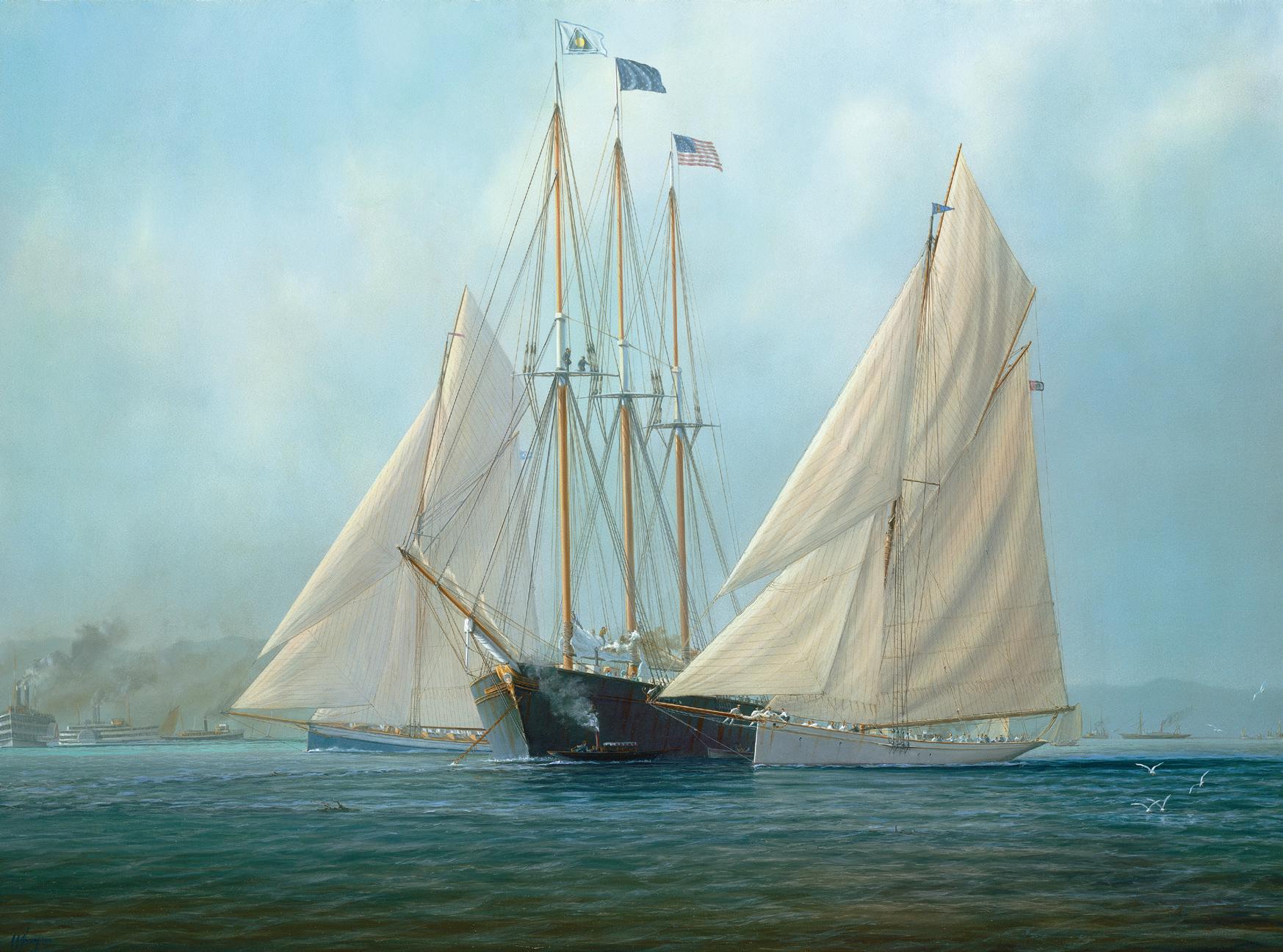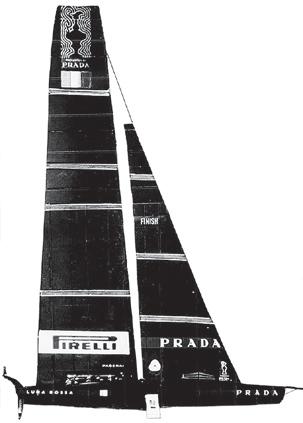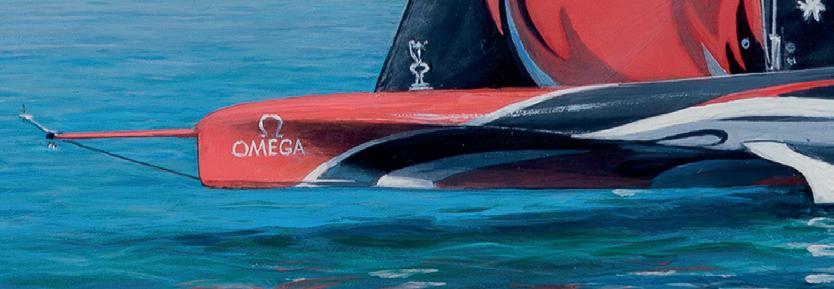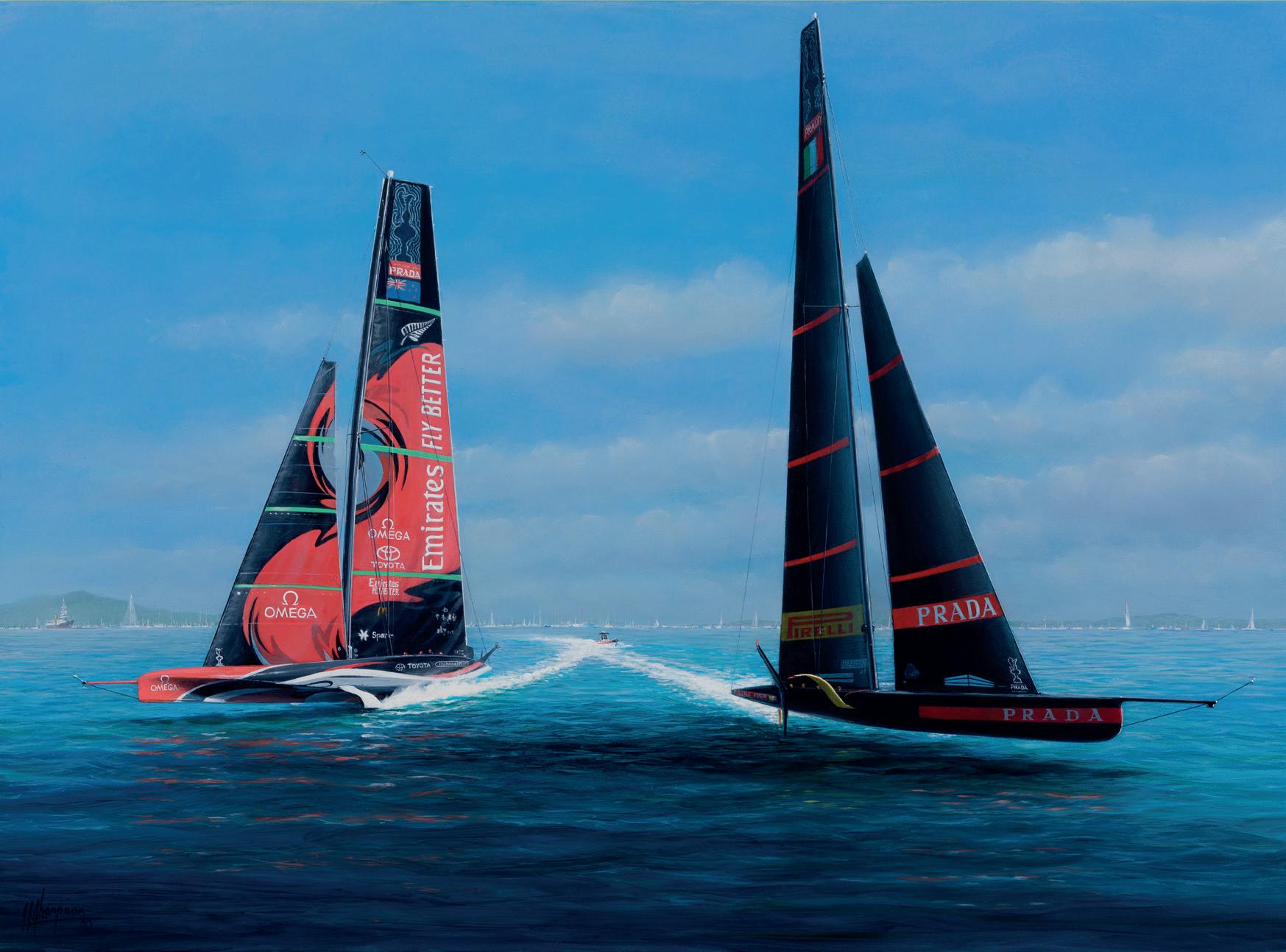
6 minute read
The Courses
2021 te rehutai defeats luna rossa
LOH: 86ft (26.2m) LWL: 72.2ft (22m) beam: 45.9ft (14m) mast height: 87ft (26.5m) wingsail area: 1560sq ft (145m2) crew: 11 + guest type: monohull
Te Rehutai ‖ Royal New Zealand Yacht Squadron

team: Emirates Team New Zealand team leader: Grant Dalton skipper: Glenn Ashby helmsman: Peter Burling tacticians: Blair Tuke, Ray Davies builder: Team New Zealand

Luna Rossa ‖ Circolo della Vela Sicilia
team: Luna Rossa Prada Pirelli team principle: Patrizio Bertelli operations: Gilberto Nobili skipper: Max Sirena helmsmen: Jimmy Spithill, Francesco Bruni builder: Persico Marine Four years may seem a long time between contests for the America’s Cup, but when it was rumoured that ETNZ were intending to design a foiling monohull for the next event, most challengers felt that it was not long enough to build such an innovative yacht. And it was inconceivable that it would be able to exceed the speed of the ‘scat cats’ pushed forward by Russel Coutts as the America’s Cup boats of the future, or the 47.5 knots achieved by the winning Kiwi cat in Bermuda. ‘A monohull will never be able stand up on just two foils’ warned many old salts. But they were wrong! Once the first AC75 hatched out of the egg, it was agreed that had she not been designed for all weathers the yacht would be capable of sailing at more than 60 knots, or over 70 miles per hour!
Certainly the boats were fast, unbelievably so, but by being built as fragile as a fairy’s wing they were no fairytale to sail, as the crew of American Magic entered by the New York Yacht Club, were soon to find out early in the elimination series. Caught by a violent squall as Terry Hutchinson jibed her down wind, she reared up before falling back on the water with such force that a large piece of carbon fibre was sheered from her bottom. Saved from sinking, with help from the other competitors, and then rapidly repaired, she never regained her previous mojo and was beaten in the Prada Cup (which had replaced the Louis Vuitton elimination trophy) by Luna Rossa entered by Prada Pirelli, the Challenger of Record. Luna Rossa went on to beat Ineos Team UK’s Britannia after they had won a bye to the final.
Britannia, sailed by renowned British skipper Sir Ben Ainslie, after losing every race in the December preliminaries had made such a remarkable recovery in the New Year that British hopes had been raised as high as the wind itself. But when it dropped away again so did their confidence, for Britannia, it seemed, had been designed for the more stimulating conditions expected at that time of year in the Hauraki Gulf.
Due to the AC75s’ astonishing balancing acts, wind was to play a major part in the series. Once the Cup began in earnest, Iain Murray, helmsman of Kookaburra in the 1987 America’s Cup and now the efficient regatta director, was forever having to postpone the starts and re-set the courses. On one day he was forced to cancel racing altogether. But however fickle the wind remained, it could be managed. What could not be managed was the effect its strength was to have on the performance of the competitors. After sharing the honours in the first six races, the double act of Jimmy ‘The Pitbull’ Spithill and Francesco Bruni steering Luna Rossa, found themselves shackled by one leg, due largely to the rising strength of the wind. They were powerless to stop the Kiwis from winning the Cup, as Te Rehutai revelled in the conditions she had been designed for.
Top wind speeds had always been an issue with the America’s Cup but only with the advent of foiling in 2013 was a lower limit of 5 knots set for racing. This had been changed to 6.5 knots, allowing designers to concentrate more on lifting the new boats out of the water when it failed. The one factor they were unable to control was the increasing amount of wind wash or ‘dirty air’ now being generated by the astonishing speeds of the 75-foot monohulls, each with 16-foot beam and an 87-foot-high mast.
Dirty air had always been a curse and a challenge for yacht racers, and by 2021, as illustrated by televised computer graphics, it had become a crucial element of tactical decision making. When the leading boat covered every move, it made it almost impossible for the second boat to pass, meaning that winning the start, which Peter Burling at the helm of Te Rehutai began to achieve as the Cup progressed, became of even greater significance than before.
Dirty air hit the headlines in race eight, one of the most extraordinary contests in the Cup’s history. The wind had reduced to a whisper when, surprisingly, Peter Burling, jibed Te Rehutai into what was thought to be her own dirty air. The vast crowd of New Zealanders watching from the shore, and from a spectator fleet said to number 3000, gasped in horror as she collapsed dead in the water, allowing Luna Rossa to sail past into what appeared to be an unassailable lead. Tension mounted as the Kiwis struggled to their feet while watching the Italians in dismay as they gained an almost one-mile advantage. They thought the race was lost, when much to their surprise, they saw the Italians suffer the same fate. Francesco Bruni admitted afterwards that he had misread a wind shift and tacked at the wrong moment, but the hole they had dug for themselves was terminal and by the time they had climbed out of it the Kiwis had sailed on to win convincingly. With the score standing at 5–3, the Kiwis only needed two more wins to take the America’s Cup for the fourth time. Their final race was their best, and when Peter Burling tacked sharply away from the Italians at the start, leaving them struggling to catch up, it was all over.
The racing had left many sailors breathless. Despite their initial fears, the new monohulls had been remarkable. Perhaps it was not surprising that first Luna Rossa and in turn Te Rehutai were shown to have distinct advantages in speed, for both had been in at the beginning and the Kiwis knew their winds through years of experience. However, once their secrets, as described earlier in the book, had been copied, there would be little to choose between them.
Partly due to the escalating costs of running the Cup, it was rumoured that the defenders, New Zealand, who had done a great job in Auckland, were looking for a new venue. Also, because it had been demonstrated that the first boat to cross the start line usually won, some considered it necessary to widen the course boundaries in future and re-visit the simple upwind, downwind configuration that had become the norm for match racing. The sailing world eagerly awaited the outcome.
At the start of the tenth and final clash, Te Rehutai tacks sharply away from Luna Rossa, grabbing the preferred side of the course and leading for the rest of the race.







